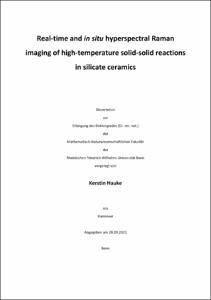Real-time and in situ hyperspectral Raman imaging of high-temperature solid-solid reactions in silicate ceramics

Real-time and in situ hyperspectral Raman imaging of high-temperature solid-solid reactions in silicate ceramics

| dc.contributor.advisor | Geisler-Wierwille, Thorsten | |
| dc.contributor.author | Hauke, Kerstin | |
| dc.date.accessioned | 2022-07-05T13:39:47Z | |
| dc.date.available | 2022-07-05T13:39:47Z | |
| dc.date.issued | 05.07.2022 | |
| dc.identifier.uri | https://hdl.handle.net/20.500.11811/9993 | |
| dc.description.abstract | Raman spectroscopy has become one of the most important analytical tools for a wide range of research areas in all sub-disciplines of physics, chemistry, biology and medicine. In the beginning the applications were limited by weak Raman signals and interfering fluorescence. Technical progress leads to higher sensitivity and a better spectral and confocal resolution. Besides point measurements there is nowadays the possibility to record false-color hyperspectral Raman images in two- or three dimensions. Acquisition times of a few milliseconds make it possible to analyze (mineral-) reactions in situ. Therefore, Raman spectroscopy is one of only a few techniques that allow an investigation of running processes on a micrometer scale. In combination with heating- or cooling stages or pressure cells it has also become possible to examine the samples under different pressure and temperature conditions, which helps to better understand technical and natural high-temperature processes such as, for instance, metamorphism. In this study the firing process of silicate ceramics in the system CaO - SiO2 ± Al2O3 ± K2O were studied in operando for the first time by in situ hyperspectral Raman spectroscopy. The samples were fired to temperatures of 650 to 1100°C and during this time analyzed in situ by hyperspectral Raman imaging. The breakdown of kaolinite and calcite and the formation of calcium (alumina) silicates could be investigated in operando, i.e., while the processes are running, and thus also without the need to quench the sample down to room temperature. Therefore, the formation temperature or -time was determined more precisely than with common ex situ temperature- or time series. Moreover, metastable or intermediate phases like pseudowollastonite and an unknown hydrous calcium aluminosilicate, possibly a zeolite, were detected, which have not been detected in ex situ experiments. The micrometer-sized spatial resolution enabled the investigation of the formation of dicalcium silicate reaction rims that formed by the reaction between lime and quartz and involves a turnover of the reaction direction. Moreover, the crystallization kinetics and the grain growth of gehlenite were studied in a series of isothermal experiments that was performed at six temperatures between 803 and 1020 ± 5°C. A single experiment thereby contained the information of a multitude of conventional sintering experiments, involving heating and quenching of different samples. A change in the activation energy of gehlenite was observed around 880°C, which may be related to the breakdown of the unknown hydrous aluminosilicate phase. The application of hyperspectral Raman spectroscopy to investigate ceramic sintering reactions combines for the first time the advantages of in situ high-temperature measurements and the spatial resolution on a micrometer scale of hyperspectral Raman imaging. With this technology, further new insights into the mechanisms and kinetics of the various solid-state reactions during ceramic firing can be expected in the future. | en |
| dc.language.iso | eng | |
| dc.rights | In Copyright | |
| dc.rights.uri | http://rightsstatements.org/vocab/InC/1.0/ | |
| dc.subject | Silikatekeramik | |
| dc.subject | HT-Ramanspektroskopie | |
| dc.subject | Korngrenzen | |
| dc.subject | Calcium-Aluminatsilikate | |
| dc.subject | HT-Raman Imaging | |
| dc.subject | Silicate ceramics | |
| dc.subject | HT-Raman spectroscopy | |
| dc.subject | In situ | |
| dc.subject | grain boundaries | |
| dc.subject | Calcium-aluminate-silicates | |
| dc.subject.ddc | 550 Geowissenschaften | |
| dc.title | Real-time and in situ hyperspectral Raman imaging of high-temperature solid-solid reactions in silicate ceramics | |
| dc.type | Dissertation oder Habilitation | |
| dc.publisher.name | Universitäts- und Landesbibliothek Bonn | |
| dc.publisher.location | Bonn | |
| dc.rights.accessRights | openAccess | |
| dc.identifier.urn | https://nbn-resolving.org/urn:nbn:de:hbz:5-67108 | |
| dc.relation.doi | https://doi.org/10.1111/JACE.15209 | |
| dc.relation.doi | https://doi.org/10.3390/app9071310 | |
| dc.relation.doi | https://doi.org/10.3390/min10030287 | |
| dc.relation.doi | https://doi.org/10.1007/s40789-019-0252-7 | |
| ulbbn.pubtype | Erstveröffentlichung | |
| ulbbn.birthname | Stange | |
| ulbbnediss.affiliation.name | Rheinische Friedrich-Wilhelms-Universität Bonn | |
| ulbbnediss.affiliation.location | Bonn | |
| ulbbnediss.thesis.level | Dissertation | |
| ulbbnediss.dissID | 6710 | |
| ulbbnediss.date.accepted | 20.12.2021 | |
| ulbbnediss.institute | Mathematisch-Naturwissenschaftliche Fakultät : Fachgruppe Erdwissenschaften / Institut für Geowissenschaften | |
| ulbbnediss.fakultaet | Mathematisch-Naturwissenschaftliche Fakultät | |
| dc.contributor.coReferee | Jansen, Helge | |
| ulbbnediss.contributor.orcid | https://orcid.org/0000-0001-6649-7396 | |
| ulbbnediss.contributor.gnd | 126314294X |
Dateien zu dieser Ressource
Das Dokument erscheint in:
-
E-Dissertationen (4379)




